ok, finally released a stable version of this drawing tool for anyone to test it!
Tag Archives: final project
[sims 2014] Ribbon drawing prototype
 I’m trying to finish this “ribbon drawing” tool. It is now stable, allowing users to add, reset and erase the shapes. I also added some new physics simulations (attraction, wind) and fixed others — springs are stable and oscillation can interact with other simulations.
I’m trying to finish this “ribbon drawing” tool. It is now stable, allowing users to add, reset and erase the shapes. I also added some new physics simulations (attraction, wind) and fixed others — springs are stable and oscillation can interact with other simulations.
Finally, I added the option to “playback” the drawing and record everything as a png sequence — so people can use it to make videos.
Github repo here.
[sims 2014] Vector Fields
1. Changing direction based on mouse movement.
2. Reading pixels from camera and changing direction of vector field based on their brightness.
3. 3D vector field with Perlin noise. The skecth is pretty buggy, though. I wasn’t able to add a camera nor particles. Any simple change makes it crash.
Github repo here.
Moneytime – Data Visualization Project Proposal
1. The topic you are interested in for your final.
Personal finances. I am still pursuing a way to approach the topic in a different way from the existing apps.
I want to make a Chrome extension that will convert any money value from any web page to time value. For example, while navigating through the Amazon website, users would see values such as “5 hours”, “3 months,” “15 minutes” etc.
2. How you will research (find data, check its source, further investigation).
We* are still discussing how exactly this conversion will work. Our first idea was to make a simple (total income)/(total hours of work) calculation. Though simple and straightforward, this equation might not make sense for everyone. People we have been talking to have mentioned a different value for working time and leisure time, for instance.
Anyway, the extension will certainly ask users for some information before making any conversion. It also needs to connect to an online service to check exchange rates — to convert values between different currencies.
3. What is the story you are trying to tell? THIS MUST BE ONE SENTENCE ONLY.
How people can see the money they spend through a non-monetary perspective.
4. What kind of visualization you want to make (bar, pie, tree, etc.)
The final result doesn’t fit in any of these visual categories. Instead, the intention is to display the converted value as html text, using the same styling as the original monetary value. That is important to keep the visual consistency of the page.
Also, I think that “visualization” should refer to any device that helps people understand better a set of information. That can be achieved by means other than “visuals.”
In the case of this project, translating money to time is a way of making people “see” their spendings in a more insightful manner. This translation doesn’t have the intention of making people spend less, save more money, plan for the future etc — the usual goals of regular finance apps. Instead, it proposes a critical view on the topic that might be interpreted differently according to each individual’s relationship with his/her own money and time.
All the f***ing lines from “The Wolf of Wall Street”
Third iteration of the movie mashup project. Now searching for specific words in a movie — also based on the subtitle.
I am not counting the words in Processing, so I copied and pasted the subtitles from “The Wolf of Wall Street” into Textalyser. The first words by far in the ranking are “you” and “what” — not very meaningful, though.
So I used “fucking,” third one with 211 occurrences. Taking a look at the full list, “fuck” and “fucking” also appear a lot of times. Because they are sort of variations of the same thing, I searched for any time that any of them is said — 431 times total. That happens in 351 subtitles — sometimes more than once in a single line, then.
Code on Github.
Repeteated Movie Lines
Another iteration of the movie mashup project. This one searches for repeated lines in a movie. Also based on the subtitles file.
“Groundhog Day” was an obvious choice because of its repeating plot. Interesting to notice that some of the repeated scenes were certainly shot at once, because Bill Murray’s hair looks exactly the same.
Code on Github.
Movie Lines Sorted Alphabetically
This is the first attempt towards my proposal for a generative movie mashup. The code is based on the same Processing sketch I used before to make a mashup book.
The subtitles’ time code (start and end) are used to play the movie jumping from one position to another.
The lines are sorted alphabetically and the video editing is automated based on that.
Code on Github.
Final Project – Proposal
 This project is the third in a sequence of experiments with generative narrative that I have been doing for my Major Studio class.
This project is the third in a sequence of experiments with generative narrative that I have been doing for my Major Studio class.

The first one is called Telephone.
 It is an html page in which you search for a term. The server connects to the Google Images API, gives you back an image, automatically search for the title of that image, gives you back the new image, search for its title and so on.
It is an html page in which you search for a term. The server connects to the Google Images API, gives you back an image, automatically search for the title of that image, gives you back the new image, search for its title and so on.
 It might sound complex, but it’s a very simple way of mimicking the miscommunication created by the children’s game telephone — using computers instead of people.
It might sound complex, but it’s a very simple way of mimicking the miscommunication created by the children’s game telephone — using computers instead of people.
 The results generate unexpected connections. Sometimes they are completely nonsense.
The results generate unexpected connections. Sometimes they are completely nonsense.
 Sometimes they seem to make sense.
Sometimes they seem to make sense.
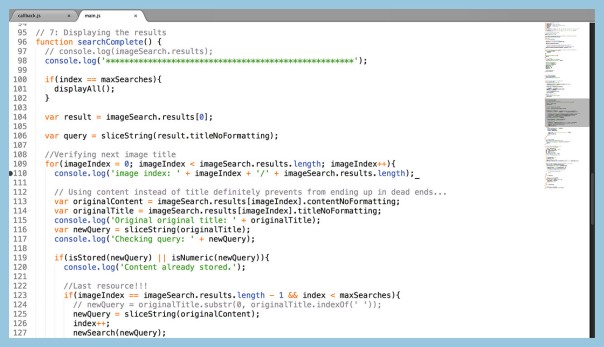 When I first presented it, I didn’t explain the technicalities involved. Then I asked people how comfortable they felt about not really understanding what was going on behind the scenes.
When I first presented it, I didn’t explain the technicalities involved. Then I asked people how comfortable they felt about not really understanding what was going on behind the scenes.
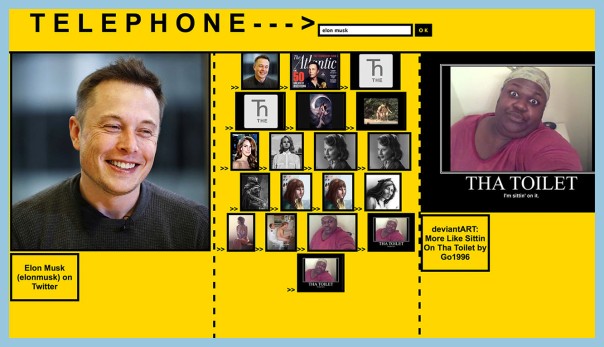 The response I got was that the connections were very clear, so no further explanations were needed.
The response I got was that the connections were very clear, so no further explanations were needed.
 That seemed to connect with these 2 principles that I was learning in the Narrative Strategies class. The second principle might be interpreted as a consequence of the first.
That seemed to connect with these 2 principles that I was learning in the Narrative Strategies class. The second principle might be interpreted as a consequence of the first.
 In a broader sense, the idea of a message being formed by the person who receives it can also relate to the psychological phenomena known as apophenia, the human tendency to see patterns. The principle has its variants, such as pareidolia, a type of apophenia associated with images or sounds. This is a very common phenomena in our lives. We experience it by seeing faces in geometric forms like the one above.
In a broader sense, the idea of a message being formed by the person who receives it can also relate to the psychological phenomena known as apophenia, the human tendency to see patterns. The principle has its variants, such as pareidolia, a type of apophenia associated with images or sounds. This is a very common phenomena in our lives. We experience it by seeing faces in geometric forms like the one above.
 We also experience it when we see Jesus’ faces on toasts.
We also experience it when we see Jesus’ faces on toasts.
 An interesting manifestation of apophenia in literature is the short story “The Library of Babel,” by Jorge Luiz Borges. In the story, people inhabit a library full of books made out of 25 characters sorted in every possible order. Most books are unreadable and completely nonsense. Even so, people believe that there might be books containing useful information and even predictions of the future, because all possible permutations are contained in the books.
An interesting manifestation of apophenia in literature is the short story “The Library of Babel,” by Jorge Luiz Borges. In the story, people inhabit a library full of books made out of 25 characters sorted in every possible order. Most books are unreadable and completely nonsense. Even so, people believe that there might be books containing useful information and even predictions of the future, because all possible permutations are contained in the books.
 These ideas led me to a second experiment called Her Weird Science.
These ideas led me to a second experiment called Her Weird Science.
 It is a mashup of Her and Weird Science — a teenage movie from the 80’s directed by John Hughes.
It is a mashup of Her and Weird Science — a teenage movie from the 80’s directed by John Hughes.
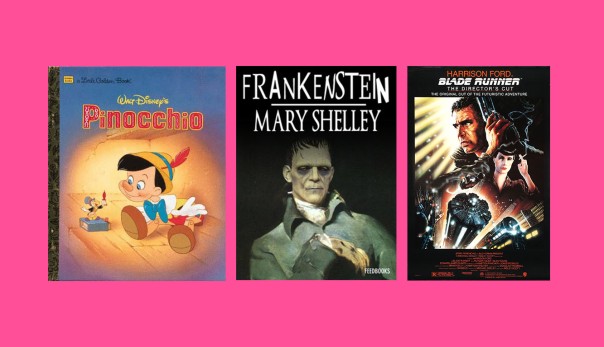 I chose the two inspired by the ideas of archetypal stories, that is, basic plots that repeat over different narrative pieces. Both Her and Weird Science tell the story of men playing God, recreating human intelligence. The same plot is also found in Frankenstein, Pinocchio, and in more recent pieces of science fiction.
I chose the two inspired by the ideas of archetypal stories, that is, basic plots that repeat over different narrative pieces. Both Her and Weird Science tell the story of men playing God, recreating human intelligence. The same plot is also found in Frankenstein, Pinocchio, and in more recent pieces of science fiction.
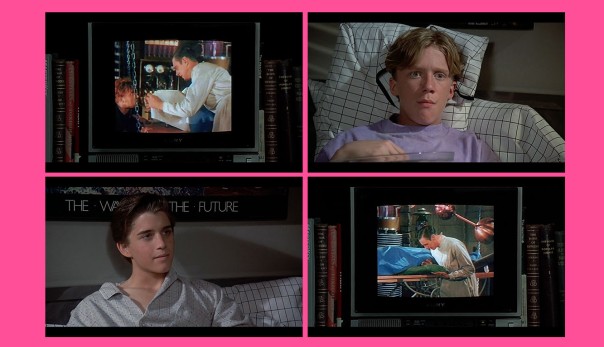 This is very explicit in one of the initial scenes from Weird Science, in which the characters are watching Frankenstein.
This is very explicit in one of the initial scenes from Weird Science, in which the characters are watching Frankenstein.
 That explains the content. The narrative strategy, though, is based on letting users construct their own stories in their minds. Technically, I mashed up the subtitles from the 2 different movies and sorted them based on the time index of each subtitle.
That explains the content. The narrative strategy, though, is based on letting users construct their own stories in their minds. Technically, I mashed up the subtitles from the 2 different movies and sorted them based on the time index of each subtitle.
 Then I printed a book with the result.
Then I printed a book with the result.
 There is no visual differentiation telling users about which sentence belong to which movie. Like in the Telephone project, sometimes the result is pure nonsense and sometimes it seem to construct a cohesive narrative.
There is no visual differentiation telling users about which sentence belong to which movie. Like in the Telephone project, sometimes the result is pure nonsense and sometimes it seem to construct a cohesive narrative.
 There are fortunate cases in characters from both movies talk about the same subject.
There are fortunate cases in characters from both movies talk about the same subject.
 At last, my project for Narrative Strategies is a sequence of these two previous experiments. It will once again be a mashup of 2 movies.
At last, my project for Narrative Strategies is a sequence of these two previous experiments. It will once again be a mashup of 2 movies.
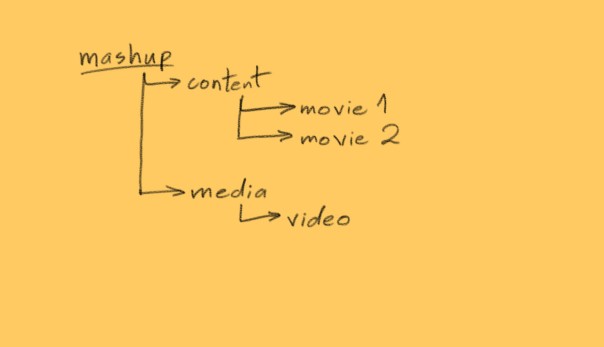 Instead of translating that to a book form, though, I’ll keep them as videos.
Instead of translating that to a book form, though, I’ll keep them as videos.
 Besides having similar stories, I’ll try to find movies with the same character names. By doing so, I’ll try to use the character names on the the subtitles to jump from one scene to another, instead of having the time-based sorting as before. This is a way of reducing the randomness in the connections.
Besides having similar stories, I’ll try to find movies with the same character names. By doing so, I’ll try to use the character names on the the subtitles to jump from one scene to another, instead of having the time-based sorting as before. This is a way of reducing the randomness in the connections.
 I intend to do that with code once more. That is not a narrative strategy, but it’s not an idiosyncratic choice either. As said in the beginning of this presentation, I’m interested in generative art. The purpose is to create an apparently cohesive narrative by playing with algorithms.
I intend to do that with code once more. That is not a narrative strategy, but it’s not an idiosyncratic choice either. As said in the beginning of this presentation, I’m interested in generative art. The purpose is to create an apparently cohesive narrative by playing with algorithms.
Final Project – Proposals
Proposal #1
a) Precedent
Visiona 2 is an exhibition created by Danish interior and furniture designer Verner Panton in 1970. It was comissioned by Bayer and took place in a boat rented by the company. Bayer wanted to create a showcase for its artificial fibers, inviting artists and designers to show its possible applications. Panton designed a hypothetical future with organic forms and vibrant colours. The rooms are also filled with smells and sounds, remaining as a still impressive example of experience design. 

 All images: Verner Panton
All images: Verner Panton
b) Idea
Translate some of Panton’s installations to virtual reality. A brainwave sensor could be used to trigger unexpected interactions with the environment — change colours and lightning, move shapes, etc. Kinect sensing could be added to make walls and objects even more responsive.
Proposal #2
a) Precedent
In the Woods is an interactive installation by swiss designer Camille Scherrer. It combines computer vision and projection mapping to recreate users’ shadows as silhouettes of animals. The half-imaginary creatures are also programmed with simple animations to interact with people.
a) Idea
A In-the-Woods-like world, with multiple shadows of the user. A Kinect can be used to track his/her movements. Animals choice can vary according to the mood, read through a brainwave sensor.
The Status Box – Final
1. Idea
A box that displays the user status — busy, available, etc. Useful for workings in semi-public spaces. One could tell by looking at the box if a person is focused on work or just checking Facebook, for instance.
2. Development
2.1. Technology
The box doesn’t have any internet connection. The status is changed by physically turning it. Also, it should be as inexpensive as possible. Instead of detecting the angle with an accelerometer, it uses 4 tilt switches — 2 for each axis, x and y. It works as in the following sketch.

2.2. 1st Prototype
I’ve programmed all functions and assembled the circuit on the breadboard before putting anything inside the enclosure:
https://vimeo.com/82378448
2.3. Enclosure
The box is made out of plexiglass and assembled with bolts and nuts only. I drew its plan based on the model found here.

Once again, a huge thank you to Brendan Byrne for the tip!
I had no experience with laser cutting plexiglass, so I ended up melting it. Anyway, it was useful to check if the box plan was right.

2.4. 2nd Prototype
With everything working on the breadboard, I simply stuck it into my enclosure — along with the battery and the Arduino board.
The switches are a little bit unstable. That made the colors flicker while I moved the box. But the main function seemed to work fine.
2.5. Final Circuit and Board Assembling
Once again, this was the hardest part. I used solder AND hot glue, because working with the tape in the previous project was a pain. It didn’t make things easier, though. I build an x and y axis with toothpicks, for the switches.
Also, I had a little less space. Because of that, I ended up glueing the battery to my Arduino.




